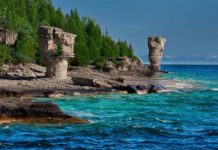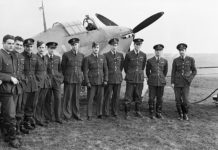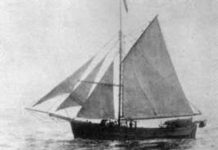Only teen-aged passengers Christine Morrison and Duncan Tinkiss survived the September 14, 1882 nautical disaster on Georgian Bay.
The flat-bottomed ship Asia, built to travel the Welland Canal and carry only 40 passengers, refitted to accommodate extra passengers and cargo, departed during a storm that took it to the bottom of Georgian Bay.
Overloaded Ship
During the year prior to its final voyage, the Asia ran aground and partially sank in the narrow St. Mary’s River. In that era of booming lumber and shipping activities, the company raised the Asia, pumped it dry, patched it, and quickly put it back into service as a Georgian Bay coastal steamer. Owned by the Great Northern Transit Company, the overcrowded ship carried an insufficient number of life jackets and lifeboats. The exact number of lives lost is not known, but estimates are that 24 crew members, 9 children, 11 women, and 85 men (mostly loggers) died.
Departing from Collingwood with scheduled stops along the way, the overburdened, top-heavy vessel carrying heavy machinery, supplies, cattle and horses for a logging camp near French River, posed steering difficulties.
Out of Owen Sound
The survivors who supplied full accounts of the horrific events stated that the Asia pulled out of Owen Sound (see attached map) into a storm during the night of September 13, 1882 with passengers crowded into whatever shelter they could find when all cabins were filled. Some attempted to sleep on the pitching deck or in chairs; some became ill as the vessel tossed about in the intensifying storm.
In the morning as waves crashed over the deck, the Captain ordered crewmen to toss shifting cargo into the water and to force livestock overboard. When his attempt to turn the ship out of the high waves failed, chaos ensued as panicking passengers fought over the few available life preservers.
Morrison and Tinkiss Struggle
Morrison’s cousin First Mate John McDonald, with a look of despair on his face, said they were doing whatever they could to improve conditions. Wearing a life jacket, she lowered herself into the water where the captain held her until her cousin could help her into a boat.
Tinkiss and his uncle left their cabin as the boat rolled “so badly we had difficulty getting up on the deck”. The boat went into a trough between huge waves, rolled heavily, and went down at about eleven thirty with the engine running. He managed to get into the first of three lifeboats, but as more people climbed aboard, the craft turned over twice and terrified people struggled to hold onto available floating items. Tossed into the water, Tinkiss removed his life jacket when he became fearful that he would be pulled down as people grabbed onto it. With the purser’s help, he climbed into the captain’s boat that held 18 people before it tipped over in high waves. The purser was among the several missing when it righted itself.
The Captain, first mate, deckhand, and cabin boy remained in the boat as it turned over again, and rose up filled with water. Before his life ended, the first mate grabbed his niece’s hair and pulled her head down, then took his last breath, and the Captain died soon after. Morrison testified that the men died quietly. “They seemed to go to sleep.” Holding on for dear life, the passengers remained silent until they sighted the light of the Bying Inlet lighthouse, but before long, only Morrison and Tinkiss remained.
Rescue and Investigations
The boat drifted in toward Pointe au Baril – an isolated area on the east coast of Georgian Bay – where Tinkiss placed the bodies on the beach, then pushed away from shore and headed for a distant oil derrick. Frightened and cold, the pair huddled near the derrick until morning when an Ojibwa couple in a canoe found them, gave them food, and took them to Parry Sound.
While Christine received medical aid for her injured leg, Tinkiss helped retrieve the five bodies on the shore. The company sent out its steamer Northern Belle furnished with coffins and ice to retrieve bodies, many of which they found considerable distance from the site of the catastrophe. For several weeks, search parties held on to the hope that they might find more survivors on isolated islands or beaches.
Morrison and Tinkiss testified at the inquest from which came criticism of government inspectors who allowed overloading and minimal training. Following the inquest and another examination of events, authorities censured Captain Savage “for want of judgment in leaving the port in the face of the storm”.
The 1882 edition of The Dominion Annual Register and Review (published in 1883) listed the victims names along with results of the inquest held in Collingwood. The jury cited undue exposure … and insufficient equipment as a result of “gross and culpable negligence on the part of some person or persons unknown to this jury, and that those persons are therefore guilty of manslaughter.
The publication also reported on the official Department of Marine and Fisheries investigation which led to steps being taken to further the cause of safety. Initially, many stated that the Asia sank after striking an uncharted shoal, though it was only one of more than 100 vessels to succumb to the Bay’s gale-force storms. The government hired Royal Navy hydrographer John G. Boulton to conduct an extensive survey of Georgian Bay and Lake Huron waters, and ordered operational changes.
Later married to Albert Fleming and mother of one son, Christine described the harrowing experience as a nightmare. The family resided in the quiet rural community of Kilsyth, Ontario until her death at age 74 in 1937. Duncan Tinkiss managed a general store and a hotel on Manitoulin Island, Ontario until his early death at age 36.
Despite many searches by divers through the years, the wreck of the Asia has not been found.







